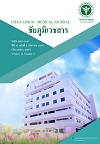ปัจจัยที่มีความสัมพันธ์กับการตัดนิ้วเท้าหรือตัดขาของผู้ป่วยแผลเบาหวานที่เท้าในโรงพยาบาลหนองบัวแดง จังหวัดชัยภูมิ
คำสำคัญ:
การตัดนิ้วเท้าหรือตัดขา, แผลเบาหวานที่เท้า, โรคเบาหวาน, ปัจจัยเสี่ยงบทคัดย่อ
วัตถุประสงค์ : เพื่อศึกษาปัจจัยเสี่ยงที่ของผู้ป่วยเบาหวานที่นำไปสู่การถูกตัดนิ้วเท้าหรือตัดขา
วิธีการดำเนินการ : ทำการเก็บข้อมูลย้อนหลัง ผู้ป่วยจำนวน 177 คน ที่เป็นแผลเบาหวานที่เท้า ตั้งแต่ ตุลาคม 2558- กันยายน 2562 โดยรวบรวมปัจจัยเสี่ยงที่อาจมีผลทำให้มีการตัดนิ้วเท้าหรือตัดขา จากนั้นวิเคราะห์ข้อมูลด้วยการถอดถอยพหุโลจิสติก (Multivariate logistic regression) เพื่อหาปัจจัยเสี่ยงที่มีนัยสำคัญทางสถิติ โดยแบ่งกลุ่มเป็น2กลุ่ม โดยใช้การตัดเท้าหรือตัดขาเป็นตัวแบ่ง
ผลการศึกษา : กลุ่มประชากรทั้งหมด 177 คน ได้รับการตัดนิ้วเท้าหรือตัดขา จำนวน 106 คน ค่าเฉลี่ยอายุ 61 ปี ซึ่งไม่มีความสัมพันธ์ที่มีนัยสำคัญทางสถิติ แต่จำนวนปีที่ผู้ป่วยเป็นเบาหวาน (Odd ratio [OR], 2.917; 95% confidence interval [CI], 1.483-5.747) มีการติดเชื้อในกระดูก (OR, 2.473; 95%CI, 1.034-6.381) โรคความดันโลหิตสูง (OR, 3.149; 95%CI, 1.398-7.221) ระดับความลึกการติดเชื้อของแผล ≥ grade 4 (Wagner’s Classification) (OR, 7.000; 95%CI, 0.875-315.338) Serum Albumin<3 g/dl (OR, 2.971; 95%CI, 1.153-8.595) eGFR<60 mL/min/1.73m2 (OR,2.011; 95%CI, 1.044-3.877) และHbA1c>9% (OR, 2.008; 95%CI, 1.026-3.929) ซึ่งเป็นปัจจัยเสี่ยงที่มีความสัมพันธ์กับการตัดนิ้วเท้าหรือตัดขาอย่างมีนัยสำคัญทางสถิติ
วิจารณ์และสรุปผล : สำหรับปัจจัยทำนายการถูกตัดนิ้วเท้าหรือตัดขาในผู้ป่วยโรคเบาหวานที่มีแผลที่เท้าที่มีนัยสำคัญทางสถิติจากการศึกษาครั้งนี้ สามารถสร้างแบบประเมินและระบบการแบ่งชั้นความเสี่ยงของโรคเบาหวานเพื่อให้สามารถรักษาเฉพาะบุคคลได้อย่างเหมาะสม สร้างทีมสหวิชาชีพที่มีความรู้ความเข้าใจในผู้ป่วยกลุ่มนี้ที่มีประสิทธิภาพ ทำให้ช่วยลดภาวะแทรกซ้อนและการสูญเสียอวัยวะในอนาคตได้เป็นอย่างดี
เอกสารอ้างอิง
World Health Organization. World Health Statistic 2012. [Internet]. Available from: http://www.who.int/gho/publications/world" http://www.who.int/gho/publications/worldhealth statistics/2012/en/. [cited 2016 Feb 12]
สมาคมโรคเบาหวานแห่งประเทศไทยในพระราชูปถัมภ์สมเด็จพระเทพรัตนราชสุดาฯ สยามบรมราชกุมารี. (2560). แนวทางเวชปฏิบัติสำหรับโรคเบาหวาน พ.ศ. 2560. กรุงเทพฯ : สมาคมฯ.
ณิปไทย ศีลาเจริญ. (2560). ปัจจัยทำนายการถูกตัดนิ้วเท้าหรือตัดขาในผู้ป่วยมีแผลที่เท้าจากเบาหวานชนิดที่ 2 ในอำเภอเดิมบางนางบวช จังหวัดสุพรรณบุรี. วารสารกรมการแพทย์, 42(2):58-67.
Lipsky BA, Berendt AR, Cornia PB, Pile JC, Peters EJ, Armstrong DG, et al. (2012). 2012 Infectious Diseases Society of America clinical practice guidelines for the diagnosis and treatment of diabetic foot infections. Clin Infect Dis, 54(12):132-73.
Boulton AJ, Vileikyte L, Ragnarson-Tennvall G, Apelqvist J. (2005). The global burden of diabetic foot disease. Lancet, 366(9498):1719-24.
Songer TJ. (2001). The role of cost-effectiveness analysis and health insurance in diabetes care. Diabetes Res Clin Pract, 54(Suppl 1):S7-11.
Monteiro-Soares M, Martins-Mendes D, Vaz-Carneiro A, Sampaio S, Dinis-Ribeiro M. (2014). Classification systems for lower extremity amputation prediction in subjects with active diabetic foot ulcer: a systematic review and meta-analysis. Diabetes Metab Res Rev, 30(7):610-22.
Ze-Hao Huang, Si-Qing Li, Yan Kou, Lei Huang, Ting Yu, Ailing Hu. (2019). Risk factors for the recurrence of diabetic foot ulcers among diabetic patients: a meta-analysis. Int Wound J, 16(6):1373-82.
Baumfeld D, Baumfeld T, Macedo B, Zambelli R, Lopes F, Nery C. (2018). Factors related to amputation level and wound healing in diabetic patients. Acta Ortop Bras, 26(5):342-5.
Singh N, Armstrong DG, Lipsky BA. (2005). Preventing foot ulcers in patients with diabetes. J Am Med Assoc, 293(2):217-28.
Riewpaiboon A, Pornlertwadee P, Pongsawat K. (2007). Diabetes cost model of a hospital in Thailand. Value Health, 10(4):223-30.
Rerkasem K, Kosachunhanun N, Tongprasert S, Guntawongwan K. (2009). A multidisciplinary diabetic foot protocol at Chiang Mai University Hospital:cost and quality of life. Int J Low Extrem Wounds, 8(3):153-6.
Birke JA, Patout CA Jr, Foto JG. (2000). Factors associated with ulceration and amputation in the neuropathic foot. J Orthop Sports Phys Ther, 30(2):91-7.
Jin Yong Shin, Si-Gyun Roh, Basel Sharaf. (2017). Risk of Major Limb Amputation in diabetic foot ulcer and accompanying disease: A meta-analysis. J Plast Reconstr Aesthet Surg, 70(12):1681-8.
Wagner FW. (1981). The dysvascular foot: a system of diagnosis and treatment. Foot Ankle, 2(2):64-122.
Sen P, Demirdal T, Emir B. (2019). Meta-analysis of risk factors for amputation in diabetic foot infections. Diabetes Metab Res Rev, 35(7):e3165.
Huang Z-H, Li S-Q, Kou Y, Huang L, Yu T, Hu A. (2019). Risk factors for the recurrence of diabetic foot ulcers among diabetic patients: a meta-analysis. Int Wound J, 16(6):1373-82.
Sarinnapakorn V, Sunthorntepwarakul T, Deerochanawong C, Niramitmahapanya S, Napartivaumnuay N. (2016). Prevalence of Diabetic Foot Ulcers and Risk Classifications in Type 2 Diabetes Mellitus Patients at Rajavithi Hospital. J Med Assoc Thai, 99(Suppl 2):S99-105.
Serhat Uysal, Bilgin Arda, Meltem I Taşbakan, Şevki Çetinkalp, Ilgın Y Şimşir, Anıl M Öztürk, et al. (2017). Risk factors for amputation in patients with diabetic foot infection: a prospective study. Int Wound J, 14(6):1219-24.
Ugwu E, Adeleye O, Gezawa I, Okpe I, Enamino M, Ezeani I. (2019). Predictors of lower extremity amputation in patients with diabetic foot ulcer: findings from MEDFUN, a multi-center observational study. J Foot Ankle Res, 12:34.
Shin JY, Roh SG, Sharaf B, Lee NH. (2017). Risk of major limb amputation in diabetic foot ulcer and accompanying disease: A meta-analysis. J Plast Reconstr Aesthet Surg, 70(12):1681-8.
Moon KC, Kim SB, Han SK, Jeong SH, Dhong ES. (2019). Risk factors for major amputation in hospitalized diabetic patients with forefoot ulcers. Diabetes Res Clin Pract, 158:107905.
Khalid Al-Rubeaan, Mohammad Al Derwish, Samir Ouizi, Amira M Youssef, Shazia N Subhani, Heba M Ibrahim, et al. (2015). Diabetic foot complications and their risk factors from a large retrospective cohort study. PLoS One, 10(5):e0124446.
Rodrigues BT, Vangaveti VN, Malabu UH. (2016). Prevalence and Risk Factors for Diabetic Lower Limb Amputation: A Clinic-Based Case Control Study. J Diabetes Res, 2016:5941957.
Namgoong S, Jung S, Han SK, Jeong SH, Dhong ES, Kim WK. (2016). Risk factors for major amputation in hospitalised diabetic foot patients. Int Wound J, 13(Suppl 1):13-9.
Moura Neto A, Zantut-Wittmann DE, Fernandes TD, Nery M, Parisi MC. (2013). Risk factors for ulceration and amputation in diabetic foot: study in a cohort of 496 patients. Endocrine, 44(1):119-124.
Quilici MT, Del Fiol Fde S, Vieira AE, Toledo MI. (2016). Risk Factors for Foot Amputation in Patients Hospitalized for Diabetic Foot Infection. J Diabetes Res, 2016:8931508.
Se-Young Kim, Tae Hoon Kim, Jun-Young Choi, Yu-Jin Kwon, Dong Hui Choi, Ki Chun Kim, et al. (2018). Predictors for Amputation in Patients with Diabetic Foot Wound. Vasc Specialist Int, 34(4):109-116.
Saleem S, Hayat N, Ahmed I, Ahmed T, Rehan AG. (2017). Risk factors associated with poor outcome in diabetic foot ulcer patients. Turk J Med Sci, 47(3):826-31.
Kogani M, Mansournia MA, Doosti-Irani A, Holakouie-Naieni K. (2015). Risk factors for amputation in patients with diabetic foot ulcer in southwest Iran: a matched case-control study. Epidemiol Health, 37:e2015044.
ดาวน์โหลด
เผยแพร่แล้ว
เวอร์ชัน
- 2021-08-17 (3)
- 2021-08-02 (2)
- 2021-02-09 (1)
ฉบับ
บท
การอนุญาต
ลิขสิทธิ์ (c) 2021 ชัยภูมิเวชสาร

This work is licensed under a Creative Commons Attribution-NonCommercial-NoDerivatives 4.0 International License.





